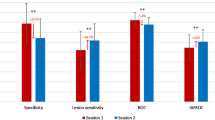Abstract
Despite the innovations in breast imaging technology, the miss rates of breast cancers at mammography screening have remained stable, ranging from 10-30% per year. While many factors have been linked to radiologist performance (such as volume of cases read, years of experience reading mammograms), little is known about the relationship between the cancers correctly reported by the radiologists and the characteristics of the background and the malignant lesion. In this study we have used the BREAST platform to allow 92 radiologists to read a case set of 60 digital mammograms, of which 20 depicted cancer. Readers were divided in 4 groups, obtained from the quartiles of the median localization sensitivity performance. Median location sensitivity for all readers was 0.71 (IQR=0.21). Statistically significant differences were observed among the groups in correctly reporting several types of lesion; for example, stellate masses were correctly reported only 37.5% by the poorest performers (median location sensitivity < 0.5), vs 88.9% by the top performers (median location sensitivity ≥ 0.92, z=-3.317, P=0.0017). When compared to top performers, the poorest performers had more difficulty reporting smaller lesions (<10mm) (40.9% vs 90.9% from top performers, z=-3.354, P=0.0008). Results suggest a link between the types of lesions more often missed by radiologists and their median location sensitivity.
Access this chapter
Tax calculation will be finalised at checkout
Purchases are for personal use only
Preview
Unable to display preview. Download preview PDF.
Similar content being viewed by others
References
GLOBOCAN Cancer Statistics on (2012), http://globocan.iarc.fr/Pages/fact_sheets_cancer.aspx (accessed March 4, 2014)
Martin, J.E., Moskowitz, M., Milbrath, J.R.: Breast cancers missed by mammography. AJR American Journal of Roentgenology 132, 737–758 (1979)
Nodine, C.F., et al.: Nature of expertise in searching mammograms for breast masses. Academic Radiology 3, 1000–1006 (1996)
Mello-Thoms, C., et al.: Effects of lesion conspicuity on visual search in mammogram reading. Academic Radiology 12, 830–840 (2005)
Beam, C.A., Layde, P.M., Sullivan, D.C.: Variability in the interpretation of screening mammograms by US radiologists: Finding from a national sample. Archives of Internal Medicine 156, 209–213 (1996)
Elmore, J.G., et al.: Variability in radiologists’ interpretation of mammograms. New England Journal of Medicine 331, 1493–1499 (1994)
Soh, P.B., et al.: Assessing reader performance in radiology, An imperfect science: Lessons from breast screening. Clinical Radiology 67, 623–628 (2012)
http://canceraustralia.gov.au/sites/default/files/publications/big-1-breast-imaging-guide_504af02b4e80c.pdf (accessed on March 9, 2014)
Reed, W.M., et al.: Malignancy detection in digital mammograms: Important reader characteristics and required case numbers. Academic Radiology 17, 1409–1413 (2010)
Rawashdeh, M.A., et al.: Markers of good performance in mammography depend on number of annual readings. Radiology 269, 61–67 (2013)
Haneuse, S., et al.: Mammographic interpretive volume and diagnostic mammogram interpretation performance in community practice. Radiology 262, 69–79 (2012)
Carney, P.A., et al.: Use of clinical history affects accuracy of interpretive performance of screening mammography. Journal of Clinical Epidemiology 65, 219–230 (2012)
Author information
Authors and Affiliations
Editor information
Editors and Affiliations
Rights and permissions
Copyright information
© 2014 Springer International Publishing Switzerland
About this paper
Cite this paper
Mello-Thoms, C., Trieu, P.D., Rawashdeh, M.A., Tapia, K., Lee, W.B., Brennan, P.C. (2014). Understanding the Role of Correct Lesion Assessment in Radiologists’ Reporting of Breast Cancer. In: Fujita, H., Hara, T., Muramatsu, C. (eds) Breast Imaging. IWDM 2014. Lecture Notes in Computer Science, vol 8539. Springer, Cham. https://doi.org/10.1007/978-3-319-07887-8_48
Download citation
DOI: https://doi.org/10.1007/978-3-319-07887-8_48
Publisher Name: Springer, Cham
Print ISBN: 978-3-319-07886-1
Online ISBN: 978-3-319-07887-8
eBook Packages: Computer ScienceComputer Science (R0)




